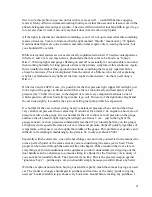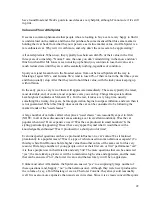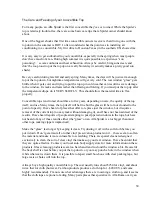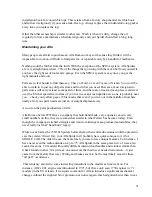
20
fluid or gear oil. Leaks of this nature can indicate expensive repairs are needed. Pay special
attention to rear ends coated with thick, greasy oil
engine oil usually doesn
“
t drip THAT far
back (and tends to be a lot less viscous than gear oil), and this could be a sign of a failed pinion
seal (in and of itself not a problem, but if the owner let it go the rear axle will get and stay very,
very loud).
Open the radiator (when the engine is cold) and run your finger around the filler neck. It should
be clean and free of any goop. If you come up with a glob of Vaseline-like stuff, the car has a
leaking head gasket. Again, this is not something to necessarily disqualify the car, but you should
be able to knock several hundred dollars off the price.
”
Choke cables
„
on SPICA-equipped Spiders should be examined very carefully. I know that
Series 2 SPICA cars, at least, came with a choke-like mechanism that, at first glance, seems to
act as a kind of mechanical cruise control. In fact, they are really intended to help set the throttle
for the first morning cold start (if you have one that works, DON
“
T use it as a cruise control
it
doesn
“
t release with the brake and can be VERY dangerous if used in that fashion).
These must break a lot because I
“
ve only seen two cars with ones that functioned. These cables
go to the throttle linkage. Cables that go all the way into the SPICA pump itself are mechanical
aftermarket replacements for a device called a
”
thermostatic actuator
„
, called a
”
TA
„
for short.
TA
“
s acts as automatic chokes for the SPICA unit, but are fragile, expensive, and tend to wear
out over time. They are nearly identical in form and function to thermostats found on most older
refrigerators. Because the replacement cost is so high (usually around $200), many owners opt
instead for a mechanical cable device. Whether you want to put up with one of these is your
business (I tend to be of the opinion that
”
sophisticated
„
Italian sports cars with exotic induction
systems shouldn
“
t have something that I expect to see on an old International Harvester Scout,
but I
“
ve been called a purist before). The system can be re-fitted with a proper actuator, but at
some cost.
When driving, the cars should track straight and have very little slack in the steering, regardless
of age or mileage. If the car has more than 1 inch of free play in the steering, then something has
worn out under there. Diagnosing such problems can be difficult. If you don
“
t feel qualified, take
it to an alignment shop and have them look at it to tell you what, if anything, is wrong.
It is also quite normal for the cars (any year) to have poor second gear synchros. The symptoms
of this are a
”
buzz
„
or
”
grind
„
noise when you try to quickly shift to second gear. Even long time
Alfa owners sometimes graunch a second gear shift. Alfa never seemed to get around to fixing
this problem, perhaps because it would have required a redesign of the entire gear box. The
sychros themselves were designed by Porsche, leading more paranoid Alfisti to postulate
conspiracy theories. The only real cure for this is to shift slowly, pausing briefly between first
and second.
It is also normal for first gear to be difficult to engage after the car has been sitting still with the
box in neutral and the clutch released. Lightly pull the shifter down to second before going up to
















































